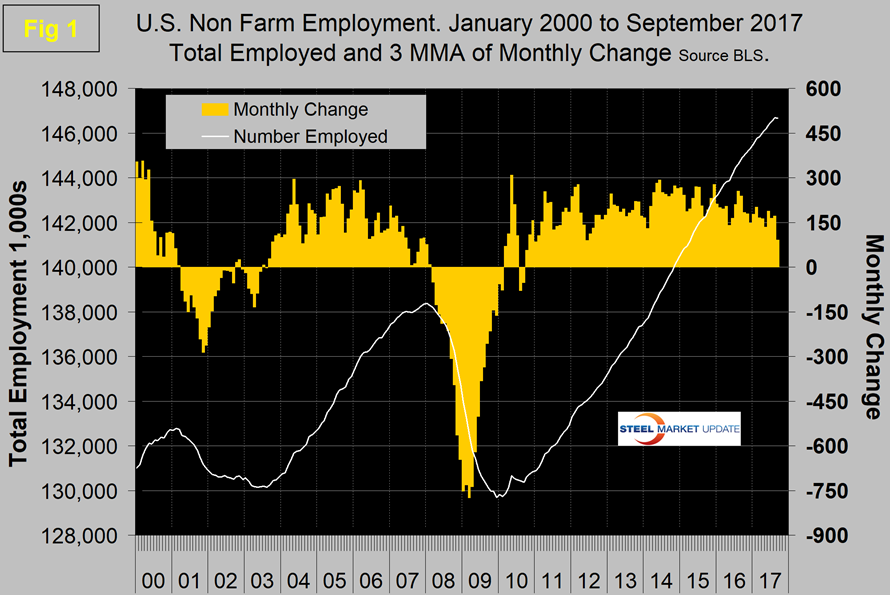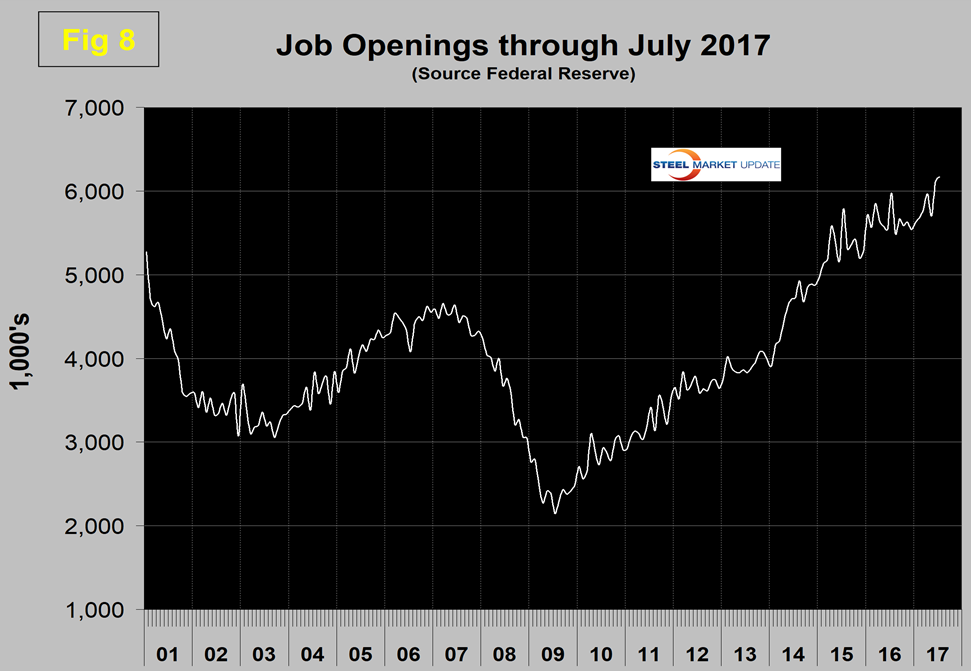Market Data

October 11, 2017
Job Creation Faces Headwinds, Not Just Hurricanes
Written by Peter Wright
U.S. employment contracted in September, and there was more going on than just hurricanes.
The Bureau of Labor Statistics (BLS) net job creation report released on Friday was very disappointing for more reasons than the impact of hurricanes, though they undoubtedly had a big effect. Net job creation in September was negative 33,000 positions. July was revised down by 51,000 and August was revised up by 13,000.
Figure 1 shows the three-month moving average (3MMA) of the number of jobs created monthly as the brown bars since 1990. The white line tracks the number employed. The results are seasonally adjusted by the BLS.
In order to examine if any seasonality is left in the data after adjustment, we have developed Figure 2. In the seven years since and including 2011, job creation in September has been up by 14.4 percent. This year, September was down from positive 169,000 in August to negative 33,000 in September. History says that October will surge, but this may be too soon for the hurricane effect to me mitigated.
Total nonfarm payrolls are now 8,294,000 more than they were at the pre-recession high of January 2008. November 2014 was the first month for total nonfarm employment to exceed 140 million. At the end of September 146,659,000 people were employed.
Table 1 breaks out the total number employed into private, government, service and goods-producing industries and the change in those sectors in the latest month of data. It includes the percentage growth in three, 12 and 24 months. Most of the goods-producing employees work in manufacturing and construction. We have identified the components of these two sectors that are most relevant to steel consumption.
In September, 40,000 jobs were lost in the private sector and government gained 7,000. Not relevant to steel but of interest from the taxpayers’ point of view, employment by the federal government was unchanged after three losing months, state governments gained 2,000 jobs and local governments gained 5,000 jobs. Since February 2010, the employment low point, private employers have added 17,065,000 jobs as government has shed 139,000 as shown in Figure 3. (The spike in government employees in May 2010 was the temporary employment of census workers).
The increase in government employment has been stalled for a year. In September, service industries lost 42,000 jobs as goods-producing industries gained 9,000. Goods-producing are mainly construction and manufacturing. Since February 2010, service industries have added 14,474,000 and goods-producing 2,452,000 positions. In other words, goods-producing industries have created only 17 percent as many jobs as service industries. The widening of the gap between services and goods-producing is part of the reason why wage growth has been slow since the recession, as service industries on average pay less than goods-producing industries such as manufacturing.
In September, the major effect of Hurricanes Harvey and Irma was in leisure and hospitality, which lost 111,000 positions, most likely in Florida. We won’t know the details of how much Texas and Florida were impacted until the state data comes out around the 25th of this month. Moody’s believes that based on the experience of previous hurricanes, the September numbers are likely to undergo dramatic upward revisions.
In September, manufacturing lost 1,000 positions but July was revised from a 26,000 gain to an 11,000 loss. All the revision was in motor vehicles and parts; therefore the summer re-tooling shutdowns must have been more extreme than the BLS realized. Manufacturing employment has increased by 0.2 percent in three months and by 0.9 percent in 12 months. Table 1 shows that primary metals have done better than manufacturing in the last 12 months, but have lost ground in the last three months. Within the big picture of manufacturing, oil and gas extraction was the only bright spot with gains of 1.2 percent in three months and 1.9 percent in 12 months. Truck transportation has lost ground in the last three months, but not by much. Note the subcomponents of both manufacturing and construction shown in Table 1 don’t add up to the total because we have only included those that are most relevant to the steel industry.
Construction was reported to have gained 8,000 jobs in September and is up by 128,000 in the first nine months of 2017. Some of the major construction subcategories are routinely reported one month in arrears, which distorts the data in Table 1. These include industrial buildings, commercial buildings, and highways and streets. Construction has added 1,411,000 jobs and manufacturing 994,000 since the recessionary employment low point in February 2010 (Figure 4). Construction has leapt ahead of manufacturing as a job creator, but the growth of construction productivity is very low (or non-existent) in contrast to manufacturing, which historically has been much higher. The difference is the difficulty of automating construction jobs.
The official unemployment rate, U3, reported in the BLS household survey (see explanation below) came in at 4.2 percent in September, which was down from 4.4 percent in August and down from 4.9 percent in September last year. This number doesn’t consider those who have stopped looking. The more comprehensive U6 unemployment rate was down from 9.7 percent in September 2016 to 8.3 percent in September 2017 (Figure 5).
U6 includes workers working part-time who desire full-time work and people who want to work but are so discouraged that they have stopped looking. The differential between these rates was usually less than 4 percent before the recession, but is still 4.1 percent. The employment participation rate at 63.1 percent in September hasn’t changed much in the last 12 months. The Labor Force Participation Rate is a simple computation: You take the Civilian Labor Force (people age 16 and over who are employed or seeking employment) and divide it by the civilian non-institutional population (those 16 and over not in the military or committed to an institution). The result is the participation rate expressed as a percent. Another measure is the number employed as a percentage of the population, which seems to us to be more definitive. In September, this measure was 60.4 percent up from 59.7 percent in September last year and from 59.3 percent in September 2015. Figure 6 shows both the participation rate and the employment to population ratio on the same graph. It has been estimated that the economy needs to create about 150,000 jobs per month to keep up with population growth. In the last 12 months, the average monthly job creation has been 148,000 per month. Therefore, since the ratio to population has improved, it looks as though the 150,000 number is too high.
In the 33 months since and including January 2015, there has been an increase of 6,756,000 full-time and 144,000 part-time jobs. Figure 7 shows the rolling 12-month total change in both part-time and full-time employment. This data comes from the household survey and part-time is defined as less than 35 hours per week. Because the full-time/part-time data comes from the household survey and the headline job creation number comes from the establishment survey, the two cannot be compared in any particular month. To overcome the volatility in the part-time numbers, we have to look at longer time periods than a month or even a quarter, which is why we look at a rolling 12-month average for this component of the employment picture shown in Figure 7.
The job openings report known as JOLTS is reported on about the 10th of the month by the Federal Reserve and is over a month in arrears. Figure 8 shows the history of unfilled job openings through July when openings stood at 6,170,000— an all-time high. There has been an improving trend since mid-2009.
Initial claims for unemployment insurance, reported weekly by the Department of Labor, increased dramatically in September. We always report a four-week moving average of this data to smooth out short-term variations, but even so there have been four consecutive increases in the data to the highest level since February 2016. Economy.com had this to say on Thursday: “The high levels of initial claims are a testament to the havoc hurricanes Harvey and Irma wreaked. However, new filings are declining in Texas and Florida as the impacts on the labor markets fade. Advanced not seasonally adjusted new filings fell 3,040 in Texas and 3,765 in Florida in the week ended Sept. 30. Turning to Puerto Rico, which was hit by Hurricane Maria, advanced not seasonally adjusted new filings fell 174 in the week ended Sept. 30. However, the decline in Puerto Rico is because the hurricane is preventing claims from being filed and processed. As this backlog is worked off in subsequent weeks, initial claims in Puerto Rico are sure to rise. This is still the longest streak since 1973 of initial claims below 300,000 (Figure 9).”
The last piece of the employment puzzle that we examine is the Challenger report, which measures job cuts monthly (Figure 10). This data also tends to be quite erratic; therefore, we again examine a rolling 12-month average and can see that job cuts decreased for most of 2016 and continued their downward trend in 2017. The result for September was the lowest since our data stream began at the end of 2007.
SMU Comment: Hurricanes Harvey and Irma had very negative effects on job creation in September, but beyond that the data are mixed. September was about 180,000 less than the last 12-month average monthly job creation, which seems to be more than a hurricane effect. The negative revision of manufacturing job creation in July is of concern, but job openings are at an all-time high and job cuts are the lowest in our data series. September 2017 was the 90th consecutive month of job growth on a 3MMA basis. The mid-1990s was the longest sustained period of job growth since the 1940s when the streak was 96 months. Overall, we are not too discouraged with this latest update from the BLS and await the November data by which time the short-term effects should have abated.
Explanation: On the first Friday of each month, the Bureau of Labor Statistics releases the employment data for the previous month. Data is available at www.bls.gov. The BLS reports on the results of two surveys. The Establishment survey reports the actual number employed by industry. The Household survey reports on the unemployment rate, participation rate, earnings, average workweek, the breakout into full-time and part-time workers, along with many more details describing the age breakdown of the unemployed, reasons for and duration of unemployment. At SMU, we track the job creation numbers by many different categories. The BLS database is a reality check for other economic data streams such as manufacturing and construction, and we include the net job creation figures for those two sectors in our “Key Indicators” report. It is easy to drill down into the BLS database to obtain employment data for many subsectors of the economy. For example, among hundreds of sub-indexes are truck transportation, auto production and primary metals production. The important point about each of these many data streams is in which direction they are headed. Whenever possible we try to track three separate data sources for a given steel-related sector of the economy. We believe this gives a reasonable picture of market direction. The BLS data is one of the most important sources of fine-grained economic data that we use in our analyses. The states also collect their own employment numbers independently of the BLS. The compiled state data compares well with the federal data. Every three months, SMU examines the state data and provides a regional report that indicates strength of weakness on a geographic basis. Reports by individual state can be produced on request.

















